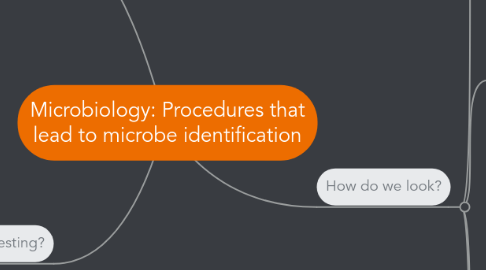
1. What are we looking for?
1.1. The microbe (Microscope)
1.2. Components of the microbe
1.3. Patient antibodies to the microbe
2. What are we testing?
2.1. Patient Sample
2.1.1. Blood
2.1.2. Urine
2.1.3. Tissue
2.1.4. CSF
2.1.5. And so and so forth...
3. How do we look?
3.1. Culture
3.1.1. Blood Agar
3.1.1.1. Beta-Hemolysis (total lysis)
3.1.1.2. Alpha-Hemolysis (incomplete lysis)
3.1.1.3. Gamma-Hemolysis (no lysis)
3.1.2. Special Specific Agar
3.1.2.1. Chocolate Agar (lysed RBC)
3.1.2.1.1. Standard Version used for Haemophilus spp and Neisseria spp
3.1.2.1.2. Thayer-Martin or New York City agars are Chocolate Agar with antibiotics to prevent the growth of competing normal flora
3.1.2.2. Regan-Lowe (Charcoal Blood) Agar
3.1.2.2.1. Used for the culture of Bordetella pertussis (causes whooping cough)
3.1.2.3. Thiosulfate-citrate-bile salts-sucrose (TCBS) Agar
3.1.2.3.1. Alkaline media for Vibrio cholerae
3.1.2.4. (Buffered) charcoal-yeast extract (BCYE) Agar
3.1.2.4.1. Used to grow Legionella
3.1.2.5. Lowenstein-Jensen (L-J) Agar
3.1.2.5.1. Used to grow mycobacterium
3.2. Microscopy
3.2.1. Gram Stain
3.2.1.1. Positive
3.2.1.2. Negative
3.2.2. Acid-fast Stain
3.2.2.1. Positive
3.2.2.1.1. Mycobacterium, Nocardia (partial staining), and oocytes of Cryposporidium, Cyclospora and Ispora
3.2.2.2. Negative
3.2.3. Wet Mounts
3.2.3.1. Used for urine sample - assess motility and shape
3.2.4. Dark Field Microscopy
3.2.4.1. Useful for spirochetes (eg syphilis) too thin to be seen by Gram stain or wet-mount light microscopy
3.2.5. Fluorescent Microscopy
3.2.5.1. Auramine-Rhodamine Dyes
3.2.5.1.1. Bind non-specifically to waxy cell wall of Mycobacterium and Nocardia
3.2.5.2. Antibody Staining
3.2.5.2.1. Fluorophore attached to antibody binds (directly or indirectly) to antigen.
3.2.6. Electron Microscopy
3.3. Detection of microbial products
3.3.1. Antigen detection
3.3.1.1. Enzyme-linked Immunoassay (ELISA)
3.3.1.2. Fluorescent Microscopy
3.3.2. Enzyme or Toxin Activity
3.3.2.1. Nagler Test
3.3.2.1.1. Test for Clostridium perfringens alpha-toxin (a lecithinase)
3.3.2.2. One Major Carbohydrate Substrate
3.3.2.2.1. Growth in broths with only one carbohydrate
3.3.2.2.2. MacConkey Agar
3.3.2.3. Specific substrates
3.3.2.3.1. Used in automated identification systems
3.3.2.4. Rapid enzyme tests
3.3.2.4.1. Catalase
3.3.2.4.2. Oxidase (Cytochrome C oxidase)
3.3.2.4.3. Nitrate reductase (Urine dipstick tests)
3.3.2.5. Growth under specific conditions
3.3.2.5.1. Used to identify certain metabolic features (Eg aerobe or anaerobe)
3.3.3. Nucleic Acid Detection
3.3.3.1. Application of gene probes to microbes
3.4. Detection of immune response to microbe
3.4.1. Detection of patient antibodies - Ab levels are quanified
3.4.1.1. IgM usually shows recent infection
3.4.1.2. IgG usually shows older infection or exposure
3.4.2. A positive skin test
3.4.2.1. Eg Mantoux test for TB
